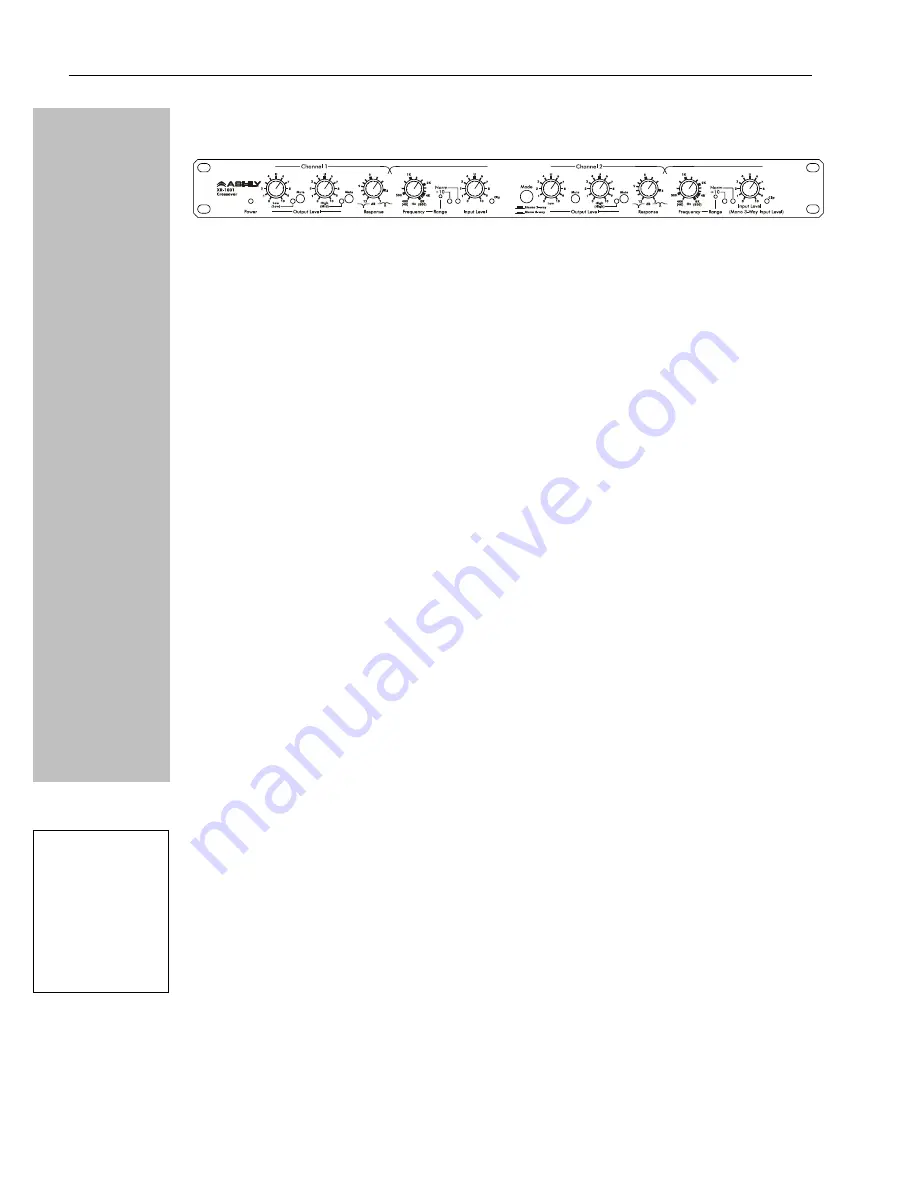
Page - 4
Operator Manual – XR 1001 Crossover
Copyright© 2012 – Ashly Audio Inc.
Physical Description
The XR 1001 is 1RU, and weighs approximately 10 pounds.
XR-1001 Front Panel
1. Power
-
Connects AC power to the unit. Power
is indicated by the frequency range LEDs.
2. Input Level -
boosts incoming signal up to
+8dB before it reaches the filters, or attenuates
the signal to off. Maximum input level is
+23dBu. The “U” shown at the 12:00 position
indicates “unity gain” of the input section.
3. Crossover Frequency -
This infinitely variable
control allows you to select an appropriate
crossover point. A turn clockwise raises the
crossover frequency while counterclockwise
lowers it. Frequencies are marked on standard
ISO 1/3 octave center frequencies with each
octave calibrated. Calibration accuracy is very
good, typically within 1/3 octave or better. If
greater accuracy than this is necessary,
measure the actual crossover frequency with
an accurate oscillator/frequency counter.
To allow a wider tuning range, our crossovers
use a recessed range switch for each
frequency control. LED indicators provide range
status as soon as the unit is powered on. The
range switch divides the frequency indicated on
the frequency control by 10 and gives a total
range of 200:1 for each control. Avoid
accidental damage to speakers by muting the
outputs before changing the range switch.
4. Response -
adjusts the damping of the filter
affecting the response shape of the filters at the
crossover point. The dial calibrations refer to
the amount of attenuation effected by the filter
at the crossover frequency, i.e., a setting of
3dB means that the filter’s high-pass and low-
pass outputs are each “rolled off 3dB at the
crossover point”. This describes Butterworth
filter response, or a gentle 3dB peak at the
crossover point where the two filter output
signals overlap. To obtain a flat signal, or
“Linkowitz-Riley” response through the
crossover region, set the Response control to
“6”. To obtain a notch at the crossover point,
turn down the response control past “6” to best
suit your needs. The purpose of this control is
to help offset the inaccuracies inherent in
typical loudspeakers, helping you to achieve a
flat system response.
NOTE: The Response control is not a “slope”
control. The Response control only affects filter
response shape in the immediate vicinity of the
crossover frequency; the ultimate crossover
slope is a fixed parameter.
5.
Output Level -
The output stage operates at
unity gain with the output level controls set at
“U”. Max gain of the output stage is +15dB. In a
typical setup, power amplifier input level
controls should be run “full-on”, with level
control being accomplished at the crossover.
Note that horn and compression driver
combinations are much more efficient than
cone speakers, often by 12 to 20dB. When
used together, you should expect a much lower
level setting for the horns to obtain proper
balance. Output mute switches allow you to
isolate individual or grouped outputs for
listening tests without affecting the settings of
any other outputs.
6. Clip Indicator -
Ashly crossovers feature a
peak detection which monitors signal level at
several critical points. The LED will flash when
signal levels of +20dBu are reached anywhere
in the crossover. Since our crossovers have a
nominal 23dB of headroom referenced to a
standard operating level of 0dBu (.77 Volts), a
flashing LED warns you that you are only 3dB
from clipping. Since peak levels are monitored
at several points, the clip LED can be used to
isolate the source. If the LED flashes even
though all input and output levels are turned
down, the signal feed is excessive. If the LED
flashes when you turn the Input level control up
(with the outputs still turned down), the
overload is occurring in the filter sections, and
you should back the Input level down a bit. If
the LED first flashes when you turn the output
level controls up, then the overload is occurring
in the output stage. In this case, if your power
amplifier controls are at full gain, you are
probably severely overdriving your amplifier.
Introduction - 2
XR Crossovers – 3
Connectors & Cables – 3
Physical Description - 4
Front Panel
Installation – 5
Typical Applications - 6
Troubleshooting - 7
Dimensions - 7
Specifications - 8
Warranty - 9
CAUTION
: High
frequency compression
drivers may be destroyed
by the use of too low a
crossover frequency.
Make sure the range
switch is properly set.
You may want to install a
security cover if the unit
is accessible to untrained
people.








